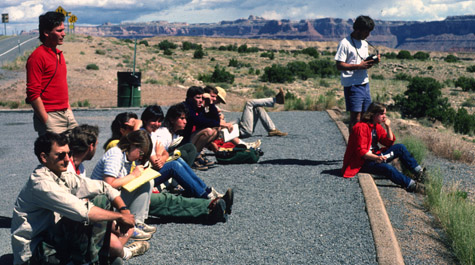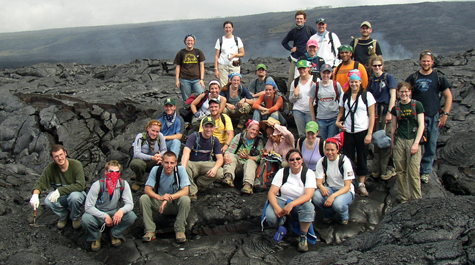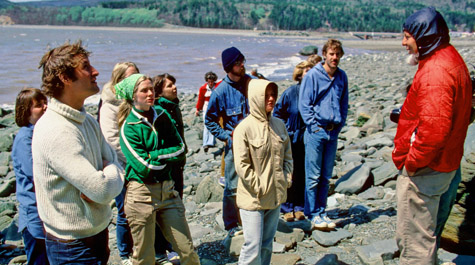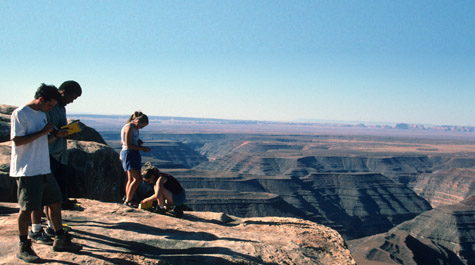An out of classroom experience
The following story originally ran in the Fall 2009 William & Mary Alumni Magazine - Ed.
Remember those hot, sticky summers when your parents made you and your siblings pile into the back of the station wagon, heading out for a long trek to see the great West? Well, for nearly four decades, geology students at William and Mary have made a similar kind of road trip - with their professors instead of parents - by signing up for the Regional Field Geology course, aka Geology 310.
Professor Gerald "Jerre" Johnson organized the first unofficial field trip in the early 1970s, and in 1976 it became a credited course known as Geology 310. During the past four decades, nearly 400 William and Mary undergraduates have signed up, with class sizes ranging from a dozen to over 30 students. The course has sparked everything from long-term research interests to wilderness survival skills, leading many students to fall in love with geology - and in some instances with each other, but those secrets remain just that.
In the early years, sleepy-eyed students would wake up the day after graduation and drive out West in two short days in a caravan. The rules of the road were strict but simple, says Johnson. "No drugs, no drinks and no electronic devices," he says. "In the van they could read, sleep, think, talk, sit there and look out the window, but no electronics," he says. "For the most part, the kids accepted this very well."
Jerry Samford '77 and his wife, Ann Markel Samford '77, both professional geologists, were on the first official trip in May 1976. Jerry doesn't remember the rules, but he does remember driving in a six- or seven-car caravan nonstop until they reached Lees Ferry at the edge of the Grand Canyon.
"We were so excited to be out of the car that most of us grabbed our sleeping bags to sleep out under the stars until it started pouring," he recalls. "Everybody told us it didn't rain in the Grand Canyon."
Samford says in many ways they were just winging it because they were the first to do it, but the experience was a vital part of any
geologist's education. "You can't replace physically touching these rocks and cliffs with pictures in a book," he says. "You can't appreciate the magnitude of the Grand Canyon unless you are standing in the middle of it."
"It was pretty special to be able to go out West and see what we had studied in books so graphically presented in the rocks," says Ann Samford. She remembers Johnson having cooking contests with the students. "He had a tremendous energy and certainly made it fun."
Johnson says it was his own experience on a field trip as a geology student that served as a catalyst to start the program. "A lot of the William and Mary students had never gone out of the state," he says. "The first few days could be quite stressful, like in the Army - you have to shape up the kids."
Although he jokes about some of the discipline stories - even deserting one student for an hour to teach her a lesson about responsibility - Johnson loved watching the students' curiosity and personalities grow. He continues to keep in touch with many of them.
"A lot of the students have gone on and become well-known in their fields in spite of us," he says with a smile.
One of those students, Chuck Bailey '89, M.A.Ed. '91, is now a professor of geology at the College. He took over the primary responsibility for the field trips in 1997 from Johnson, although several members of the department have escorted the trips over the years.
As a student on the 1987 trip, Bailey recalls that his compatriots brought fossils from the Virginia coastal plain and put them "into" the rocks in western Colorado [much older rocks with very different fossils] to be discovered by W&M students.
"Much confusion ensued," he says with a laugh.
While Professor Johnson may not have been a big fan of the students' rock and roll, Bailey says he gets cranky when students dally too long at restroom stops, keeping the class out of the field.
"In 2001, Professor Greg Hancock and I co-led the trip," says Bailey. "We had 22 students on the trip and two vans, which Greg and I piloted. The group had gotten into a pattern of the same people riding in the same vans day after day, so one morning we let the students load up in their normal vans, then we switched vehicles. Lots of students were out of sorts and unhappy campers."
But the trip is more than just learning how to travel and adjust to camp life, it is about learning geology firsthand. Jessica Ball '07, currently a graduate student in volcanology at the State University of New York at Buffalo, went on three trips - two as a student and one as a teacher's assistant (TA).
"A typical day would depend on where we were. When we camped out West in Texas or on the Colorado Plateau, for example, we'd usually get up around sunrise, cook breakfast, and put together our lunches," she says. "If we had a specific project for the day, the professors would discuss it and give us directions, and make sure we understood what the goals of the project were. If this involved groups of students, one of the trip TAs or the professors would go along with the group. We might get dropped off in one spot with topographic maps and compasses and asked to identify rock types or structures, and to take measurements and make a geologic map of a specific area.
"Field journals are a really important part of any field trip, and everyone, including the TAs and professors, should be keeping track of what they're experiencing on a trip," Ball adds. "A typical field book entry would include a date, a precise location, weather conditions, which can affect the appearance of an outcrop, a purpose and goals for the day's work, and detailed observations and interpretations about the geology being studied that day."
Now that there have been nearly 40 years of trips, the professors are more prepared for what problems may arise. During the course, which meets once a week during the spring semester, the professor will teach first aid and field behavior. "We also reenact what could happen or what has happened in the field," says Bailey.
Stories range from hospital trips for sprained ankles to the time the crew woke up to six inches of snow in western Colorado during the first week of June. The students learn a lot about survival skills and what it is like to live outside.
Perhaps the most significant outcome of the course, however, is the long-term research it has spawned. For many years, Professor Johnson took students to Fish Lake on the High Plateaus in Utah to illustrate glacial landforms. Professor Bailey continued to visit that field site during the late 1990s and early 2000s. In 2002, Caroline Webber '03 and Bailey started a research project to understand the origin of Fish Lake and its valley. This initial research grew into a multiyear project (supported by National Science Foundation and U.S. Geological Survey grants) that has now involved nine W&M undergrads and an alumnus, Professor Scott Harris '88 at the College of Charleston. The results from this faculty/student research collaboration have documented the paleoenvironmental and landscape history of central Utah during the past 30 million years.
The trip started out as a bargain, with all expenses totaling around $250-$300 according to Johnson, and has remained one over the years. In 2008 and 2009, the course fee was only $600, which paid for vehicles, gas and camping fees, plus the students are encouraged to bring around $200 money for food.
"The department subsidizes the trip with donations from alumni and grant recovery funds," says Bailey. "We don't want the trip cost to keep students from going. We hope to be able to keep it affordable for students in the future."
"Field courses are a great way to learn important skills in geology," says Ball, "but they're also a great way to make friends and to get to know your peers and professors better. I'm still in contact with people I met on my very first trip, and it helps you feel more comfortable with your classmates during the school year when you've already spent time with them outside of school."
Most trips end up covering more than 7,000 miles by the time they return to Williamsburg. Although the Colorado Plateau region is a regular destination, in the past few years the course has added new locations. In 2005 and 2007, Professor Brent Owens led trips to the Big Bend region in western Texas. The 2006 trip, led by professors Bailey and Linda Morse, spent 10 days on the Big Island of Hawaii examining volcanoes and witnessing active lava flows cooling to rock. The 2009 trip was led by Professor Greg Hancock to California and visited the Sierra Nevada, Death Valley, the San Andreas Fault and the coast. In 2010, the class will study coastal environments in the Bahamas.
The geology department hosts several trips within Virginia each year, but it is the Regional Field Course that allows most students an experience west of the Mississippi that they haven't had before.
"Most of these students haven't spent much time outside," says Bailey. "At the end of the trip, beyond what they experience as far as science goes, I hope they feel more comfortable with their abilities in the great outdoors."
 Skip to main content
Skip to main content





